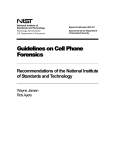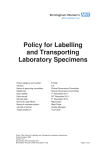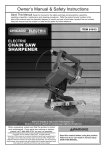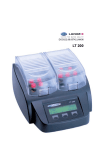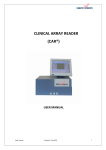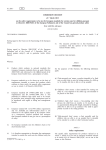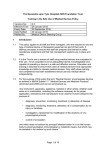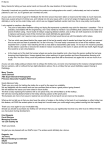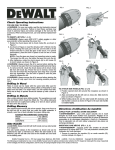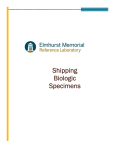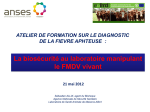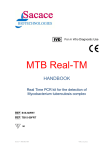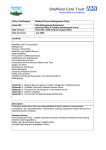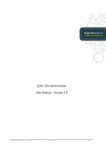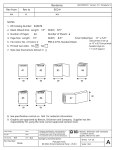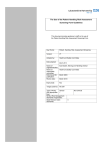Download BWH Trust policy - Birmingham Women`s Hospital Foundation Trust
Transcript
Ref:6Feb2008/A11/Enc6/V2 Policy for Labelling and Transporting of Laboratory Specimens Date of Policy: March 2008 Review Date: January 2011 Author: Nigel Coles Type: Policy for Labelling and Transporting of laboratory Specimens Version: Ref: 1 N/A Directorate: To describe a safe system for the labelling, packaging and storage of pathological specimens at ward level and principles for safe transportation from ward to laboratory by hospital porters’ and\or the use of hospital transport, taxis, couriers or the postal services. This policy applies to all employees, irrespective of grade, level, location or staff group. Aim: Scope (who it applies to) : Ratified by: Date: Final Approval by: Date: Approval Signatories Date: Implementation Date: Clinical Governance Committee Management Board Trust Board Feb 2008 Chief Executive 3.8.07 JNC 06/03/08 March 2008 Review and consultation January 2011 by Head BMS, Pathology Services Clinical Support Directorate. process (when review required & by whom): Associate Director – Clinical Support Services Responsibility for Implementation: Revisions: Date: HISTORY Review date: Effective to: Action Required by Trust/Dept Distribution methods: Author: Description of Revision (Action by whom): Effective from: All staff via Global email, Global U Drive, Intranet Please note that the electronic version of this document on U Drive is the only version maintained. Any printed copies may not necessarily contain latest updates and should be compared to the version on the U Drive. Page 2 of 18 1 The Policy All staff that request, collect and transport clinical specimens will be familiar with this policy and associated procedures. Staff will be trained in the taking of appropriate specimens in a safe manner. All staff who handle specimens will receive adequate instruction and/or training of the requirements of this policy and its associated procedures. Adequate resources will be provided to enable this policy and its procedures to be performed correctly and in a safe manner. The Birmingham Women’s Foundation NHS Trust will comply with appropriate regulations for the transport of specimens, including the ADR 2005 Regulations (The Carriage of Dangerous Goods by Road). 2 Procedure: a Background Health and safety legislation requires laboratory staff to process separately from other work, using special precautions, any specimens which are known to present, or are suspected of presenting, a risk or danger of infection to laboratory staff. In a hospital\clinic, it is likely that at any given time, there will be a number of patients presenting a risk of infection that are not identified, either because the diagnosis of clinical illness has not been made, or because the risk is present in the carrier state. Therefore, there is a need to ensure that all specimens are safely handled, contained and transported from the patient to the laboratory. If a specimen is known to present, or is suspected of presenting an infection hazard, it is essential that staff can identify the specimen and are given information sufficient to enable them to take the appropriate precautions. The NHS Litigation Authority (NHSLA) expects a safe system of work to be in place, which ensures correct patient identification of specimens and reports, and the procedure to be adopted in cases where specimen mislabeling occurs. The policy also describes the process for monitoring the effectiveness of the policy. Information about the sampling requirements for specific assays can be obtained by either phoning the appropriate laboratory or referring to each laboratory User Manual. Page 3 of 18 B Aim The aim of this Policy is to describe a safe system for the labelling, packaging and storage of pathological specimens at ward/clinic level and principles for safe transportation to the laboratory by hospital porters’ and\or the use of hospital transport, taxis, couriers or the postal services. C Definitions used Diagnostic Specimens – human or animal materials that are being transported only for the purpose of diagnosis or investigation (UN3373) Infectious Specimens – are reasonably known to contain a pathogen, and the pathogens cause infectious diseases in humans, or animals and humans (UN2814). D Development and consultation process Draft version 0.1 Pathology Management Group Draft version 0.2 Trust Health & Safety Committee Draft Version 0.3 Trust Health & Safety Committee with amendments Jacky Cotton, Trust Lead NHSLA/CNST & Gary Cockayne, Associate Director Clinical Support Services e Draft Version 0.4 Clinical Governance Group Draft Version 0.5 Trust board & JNC Specific Detail Directorate Managers It is the responsibility of Directorate Managers to ensure that: All staff in their directorate who request, collect and transport clinical specimens are familiar with this policy and associated procedures All staff in their directorate have access to appropriate parts of the policy and procedures All staff in their directorate who handle specimens receive adequate training and instruction of the requirements of this policy and its associated procedures There are adequate resources to enable this policy and its procedures to be performed correctly and in a safe manner Materials associated with this policy comply with standards recommended in this policy Page 4 of 18 They, or a delegated representative, assist with any investigation or untoward incidents, or non-compliance with this policy They determine with appropriate managers the site of specimen storage areas within their area Medical Staff It is the responsibility of medical staff to ensure that: They are familiar with and apply this policy and associated procedures. They are aware of the hazards involved to other staff of the non-compliance with this policy When requesting specimens for analysis that may present a particularly high risk of infection, the attention of staff who may take the specimen must be drawn to any risk to themselves and any special precautions necessary when taking the specimen They or staff taking these specimens are aware of any additional labelling of the specimen container\pathology request form that may be required. Clinical Staff (includes medical, midwifery, nursing and phlebotomy staff) It is the responsibility of clinical staff taking specimens to: Be trained in the taking of the appropriate specimens in a safe manner Be aware of the hazards to themselves and other staff of non-compliance with this policy Ensure the container used is the appropriate one for the purpose, is properly closed and is not externally contaminated by the contents. Ensure every request form and, where appropriate, specimen container, must contain the following details to allow laboratory staff to resolve issues, should the need arise: – describes the nature of the specimen – the patient identity information – location – date and time specimen is taken – requestors contact details – appropriate clinical information. Ensure the appropriate labelling of specimen container and pathology request form if the patient is know or suspected of having a disease considered “high risk”, as defined later in this policy. Page 5 of 18 Ensure the specimen is packaged and stored in a suitable and safe manner and in a suitable place, whilst awaiting transportation to the laboratory Ensure that any emergency specimens are adequately packaged in accordance with this policy. Ensure that if taken by ward staff to the central specimen reception point within the hospital, that specimens are carried in a safe manner. The clinician who sends the specimen must ensure that: The container used is the appropriate one for the purpose, is properly closed and is not externally contaminated by the contents Similarly, the pathology request form must not be contaminated The container is labelled with patient’s registration number (and NHS number of nonregistered BWH patients), full name, ward\department etc. “High risk” specimens (detailed in Appendix 1) must have a “DANGER OF INFECTION” label attached to the container For most specimens, the container is placed into the leak-proof pathology bag with integral request form. The bag is sealed as directed on the form. On no account are these bags to be stapled, pinned or clipped These bags are not to be re-used Specimen containers which do not fit into the pathology bag are placed in a polythene bag which is sealed by knotting or the use of tape, but never by the use of staples, pins or clips. These bags should not be re-used. The appropriate request form must accompany the specimen and must give full patient identification details. The type of specimen, time and date of collection, the required investigation and relevant clinical details, must also be given. If the integral request form\envelopes are not used, the request form is attached to the outside of the bag and not placed inside the bag with the specimen container Specimens awaiting collection are placed in the ward/clinic specimen container Specimens taken to a central reception point by ward/clinic staff for collection, must use the above box to carry the specimens. This box must be cleaned with detergent\water weekly or, if soiled, it must be cleaned immediately with 1% hypochlorite solution (see Spillage Procedure, Appendix 2). Page 6 of 18 If a taxi driver arrives to collect a specimen from the ward\clinic, the specimen must be handed over from the ward box. On no account, must the ward box be handed over to the driver. Portering Manager\Associated Staff in Clinics, Patients’ Homes etc It is the responsibility of the Portering Manager etc to ensure that: All staff in the department who transport specimens are familiar with this Policy and associated Procedures All staff in the department have access to the relevant parts of this policy and are trained in the requirements of this policy and its associated procedures. The staff in the department are aware of and know how to carry out the procedure for dealing with spillages of pathological materials in accordance with the Spillage Procedure. (Appendix 2) Spillage kits and appropriate protective equipment are available within the department and staff are aware of the spillage kit and protective clothing storage area. All materials associated with this policy comply with standards recommended in this policy and any equipment is maintained to an appropriate standard. That staff have appropriate supplies of equipment and any protective clothing necessary to perform this and associated policies. There is liaison with the appropriate departments concerning cleaning and disinfection of equipment used in this policy. Portering Staff\Associated Staff in Clinics, Patients’ Homes etc It is the responsibility of portering staff etc to: Collect and transport pathological specimens in a safe manner in the procedures accompanying this policy. Convey only those specimens which are appropriately packaged and not leaking to the point of collection Be familiar with the procedure to be undertaken in the event of leakage or spillage of specimens or other untoward event in accordance with the Spillage Procedure. (Appendix 2) Not to transport pathological specimens with any other items, e.g. waste, post, notes, xrays, unless they are segregated from such items. Not leave pathological specimens which are not in a locked box or similar carrier in public areas Page 7 of 18 To observe hygiene rules given in the accompanying “Safety Rules for Porters and Drivers” Appendix 4) Laboratory Managers It is the responsibility of Laboratory Managers to ensure that: All staff in the department who transport clinical specimens are familiar with this policy and associated procedures All staff in the department have access to appropriate parts of the policy and associated procedures. All staff in the department are trained in the requirements of this policy and its associated procedures. The staff in the department are aware of and know how to carry out the procedure for dealing with spillages of pathological materials in accordance with the Spillage Procedure. (Appendix 2) Spillage kits and appropriate protective equipment are available and that the storage sites for these materials are known by all staff in the department. All materials associated with this policy comply with standards recommended in this policy and equipment is maintained to an appropriate standard. There is liaison with the appropriate departments concerning cleaning and disinfection of equipment used in this policy. Their staff have appropriate supplies of equipment and any protective clothing necessary to perform this and associated policies. Suitable specimen storage facilities are available in each laboratory. Provide specific guidance for their service users in their user’s manual. Transport Drivers It is the responsibility of drivers to: Collect and transport pathological specimens in a safe manner as instructed in the procedures accompanying this policy. Convey only those specimens which are appropriately packaged and not leaking to the laboratory. Be familiar with the procedure to be undertaken in the event of leakage or spillage of specimens or other untoward event in accordance with the Spillage Procedure. (Appendix 2) Page 8 of 18 Not to transport pathological specimens with any other items, e.g. waste, post, notes, x-rays, unless they are segregated from such items. Not leave pathological specimens which are not in a locked box or similar carrier in public areas. Observe hygiene rules given in the accompanying “Safety Rules for Porters and Driver”. (Appendix 4) Specimens in transit must never be left unattended in an unsecured vehicle or at an unsecured location External Taxi/local transport Providers The contractor must have a Health and Safety Policy which satisfies the requirements of the Birmingham Women's Health Care NHS Trust. It is the responsibility of the contractor to ensure that all their personnel are informed of and are fully trained in the performance of this policy at all levels. It is the responsibility of the contractor to ensure that their policies and procedures reflect those contained within this policy. NB Specimens must not be left by drivers at the receiving Hospital’s Porters’ Lodge. They must be taken to the appropriate department. Categorisation of Specimens All specimens must be handled with care and treated by all personnel as potentially an infection risk Low Risk Diagnostic Specimens (UN3373) The majority of specimens collected and transported to the pathology departments do not present a significant risk of infection to staff handling them. These may be considered “low risk” diagnostic specimens. Such specimens will normally be packaged in a primary container (e.g. blood tube, swab tube, specimen pot) and an outer secondary container (a sealed pathology transport bag or sealed plastic bag). All specimens must be accompanied by an accurately, fully completed pathology request form which must preferably be integral and external to the bag. The tertiary container used to transport specimens around and between hospitals may vary in design, but must comply with the P60 specification outlined in this Policy. Page 9 of 18 High Risk Infectious Specimens (UN2814) Some patients may be suffering from or be suspected of having a disease which may present a higher risk to staff. Legislation requires specimens from such patients to be identifiable. A list of diseases presenting such a risk and the specimens from those patients constituting “high risk” specimens are given in Appendix 1. The specimen containers and pathology transport bags used for these specimens will be identical to those used for routine specimens. The identification of risk associated with these specimens will be by the use of “DANGER OF INFECTION” labels. The specification for these labels is given in Appendix 3. It is the legal responsibility of the person who requests the laboratory examination of the specimen to ensure that both the request form and the container are correctly labelled to indicate a danger of infection. “DANGER OF INFECTION” labels must only be used for specimens which are suspected of or are known to contain pathogens listed in Appendix 1. Specimens that Contain Other Hazardous Materials These include, pathological specimens which contain radioactive material, cytotoxic drugs, and specimen containers which may contain hazardous reagents. These represent a minority of specimens at the Birmingham Women's Health Care NHS Trust. The requirements for the transportation of radioactive materials by road, are described in the ADR 2005 regulations. Local procedures for wards and departments concerning the packaging and transportation of radioactive materials and specimens containing radioactive residues are available and have been written with guidance from the Radiation Protection Adviser. Transportation of Specimens by Road The Health & Safety Executive in conjunction with the Department of Transport in their ADR 2005 Regulations sets out the conditions under which specimens can be carried by road. It gives details relating to the packaging and labelling of any biological samples transported by such means. In view of these requirements, it is unlikely that wards would be able to comply without reference to the trusts laboratory services. Thus, any biological sample to be sent to another diagnostic laboratory should only be dispatched by the laboratory. Page 10 of 18 Any staff sending specimens through the post directly from a ward must contact, in the first instance, the Directorate Manager within the Directorate to which they are accountable for authorisation before specimens are sent. Any specimens sent via the postal services must comply with current requirements for packaging. Any protocols, other than those described here, for the transportation of specimens issued from a laboratory should be checked by the Trust’s Control of Infection team before specimens are sent through the post. Specimen Transport Procedure within the Hospital The transportation of specimens from the ward to the central point within the hospital may be performed by ward staff or porters. Porters and drivers must have a copy of “Safety Rules for Porters and Drivers”. Appendix 4. Ward staff must transport the specimens in the ward specimen storage box NOTE Specimens must be kept in locked area when unattended to prevent patient\general public access to the specimens. The boxes used to store the specimens must be washed weekly using detergent\hot water. If soiled, they must be cleaned using the spillage kit as directed. Transportation of Specimens by Taxi/local transport providers and community midwives from the Birmingham Women's Hospital. An occasional “in hours” specimen and all “out of hours” specimens are transported by private taxi. Copies of this Policy and Procedures will be available to the contracted taxi companies. Taxi drivers must have a copy of “Safety Rules for Porters and Drivers” (appendix 4) and must also be familiar with the health and safety implications of transportation of pathological specimens and how to deal with spillage\leakage of any specimens. (appendix 2) Transport boxes used by drivers must conform to the standards described in this Policy (Appendix 3). Transport boxes must not be placed on the vehicle seats. The boxes must be stored in the car boot or secured at the rear of the vehicle if an estate\transit style of vehicle is used The specimens must be transported in such a way that if leakage occurred, it would be contained within the outer container The outside of any transportation box must be labelled as per the Policy Page 11 of 18 Spillage kits and other equipment to deal with spillage must be available at the headquarters of the vehicle’s base or within the vehicle. Specimens in transit must never be left unattended in an unsecured vehicle or at an unsecured location. f Training City Hospital Birmingham provides an NVQ module in Phlebotomy. All non-medical staff who take blood must have passed this module or similar competence based assessment/qualification before undertaking phlebotomy. g Monitoring or Audit requirements. The requirements of this policy and procedures will be continuously monitored on the receipt of specimens in the laboratory. Significant discrepancies will be logged and the requesting clinician will be notified. Each laboratory department will produce an annual report detailing numbers of discrepancies and identify any significant trends or areas of the trust which consistently disregards this policy. h Associated Documents and references 1. Working with ADR. An introduction to the carriage of dangerous goods by road, Department of Transport; 2004; ISBN 1-904763-4732 2. European Agreement Concerning The International Carriage Of Dangerous Goods By Road (ADR) 2005; United Nations New York and Geneva, 2004. Available online at: http://www.unece.org/trans/danger/publi/adr/adr2005/05ContentsE.html 3. Birmingham Women’s Healthcare NHS Trust Infection Control Manual. Available at: U:\Policies&Procedures\Infection Control Manual\Policies\cleandisinf jan06.doc 4. Pathology User Manuals. Available at: U:\Pathology User Manual Page 12 of 18 1. APPENDIX 1 LIST OF SAMPLES CONSIDERED “HIGH RISK” Suspected or Proven Infections in Category 3 All Specimens 1. HIV. 2. Hepatitis B or C or D 3. All specimens from patients suffering from known or suspected viral hepatitis or the carrier state. Selected Specimens 4. All sputum and other samples that may contain tubercle bacilli even if examination for them is not requested. 5. Brain tissues and spinal cord material from patients known or suspected to have disease caused by transmissible spongiform encephalopathy agents, e.g. Creutzfeldt-Jakob disease or multiple sclerosis. 6. Stools from patients with typhoid or paratyphoid fever, E.Coli 0157, dysentry due to Shigella dysenteriae type 1. 7. Other samples as directed by the Infection Control Team. Page 13 of 18 APPENDIX 2 Further information can be found in the Trust’s Infection control Manual which can be found at U:\Policies&Procedures\Infection Control Manual\Policies\cleandisinf jan06.doc SPILLAGE KIT PROCEDURE DISINFECTION TABLETS FOR PREPARING “HYPOCHLORITE” SOLUTIONS Hypochlorite solutions are not very stable and this may cause problems when diluted, thus throughout the Policy fresh solutions are made using effervescent tablets. The solutions recommended can be prepared as shown on the package. AVOID USE ON METALLIC EQUIPMENT WHEREVER POSSIBLE. WASH HYPOCHLORITE OFF METALLIC EQUIPMENT WITH DETERGENT AND HOT WATER AND DRY. FOR BLOOD\BODY FLUID SPILLAGE – SEE SPILLAGE SECTION OF THIS POLICY. WHERE POSSIBLE, ENSURE GOOD VENTILATION WHEN USING THE HIGHER STRENGTH CHLORINE SOLUTIONS. Use of Spillage Kits These kits are only for use in cases of blood and body fluid\product spillage. NOTE: FOR URINE – SEE NOTE 3. This spillage kit contains: 1 tube of 10 x 1.8g tablets 1 x 500g disinfectant granules 1 x 1 litre bottle The following items will also be necessary to use this kit: Yellow waste bag Disposable cloths or paper towels Hot water and detergent Disposable gloves Disposable apron Methods of Use 1. Put on plastic apron and gloves. 2. Sprinkle granules liberally over spillage, ensuring complete coverage. Leave for at least 2 minutes. Do not leave unattended. 3. Scoop debris into yellow plastic bag. 4. Wipe up with damp paper towel any remaining powder – put paper towels into yellow bag. 5. Wipe area with detergent and hot water. 6. Put all disposable equipment, gloves, apron etc., into yellow bag and seal. 7. Wash hands. As an alternative to granules, 1 tablet may be dissolved in 100ml of water to give a hypochlorite solution of the same strength. This would only be for large volume or vertical spillages. A fresh solution must be made up for each incident and disposed of carefully down the a sluice. After use, the plastic bottle must be washed well and left upside down to drain before being stored dry. NOTE 1: CHLORINE GAS MAY BE GENERATED WHEN HYPOCHLORITES ARE USED – ONLY USE IN WELL-VENTILATED AREA. NOTE 2: CHLORINE CONTAINING PRODUCTS MAY BLEACH COLOUR FROM CARPETS AND UPHOLSTERY. NOTE 3: CAUTION – URINE SPILLS – CONTACT OF PRODUCTS WITH URINE WILL LIBERATE TOXIC GAS. IN THE EVENT OF URINE SPILLAGE, FIRST SOAK UP EXCESS USING PAPER TOWELS AND DISPOSE OF IN CLINICAL WASTE BAG, THEN TREAT THE AREA AS FOR BLOOD SPILLAGE. If the spillage kit is required for any other purpose, please contact the Control of Infection Team. REPLACEMENT SPILLAGE KITS ARE AVAILABLE FROM PHARMACY. Page 16 of 18 APPENDIX 3 PACKING INSTRUCTIONS USED FOR SPECIMEN COLLECTION AND TRANSPORT The following are requirements which must be met in order to ensure the safe collection and transport of specimens to the laboratory. Specimen Containers Specimen containers must be sufficiently robust to withstand the stresses likely to be put upon them and must not leak in normal use. Specimen containers and closures which are to be used more than once must be able to withstand autoclaving or disinfection and must remain leak-proof after each re-cycling process. Damaged closures or containers must be discarded and not taken back into use. Every specimen container label must describe the nature of the specimen, the identity and location of the person or details which would enable hospital staff to identify the source quickly, should the need arise. Specimen Transport Bags These will be used whether or not a specimen is considered high risk. The transport bag must be sealed by means of an integral sealing strip or by other suitable means that can be opened without the use of a sharp pointed instrument. Bags which require sealing by the use of pins, staples, or metal clips, are not acceptable. The bag should preferably have an integral request form or a suitable means of containing the form other than in with the specimen, e.g. a separate document pocket. For larger pathological specimens, a suitable bag must be considered. Specimen transport bags must not be used more than once. Specimen Transport Envelopes These will be paper envelopes to be used for specimens carried by taxis. These envelopes bear “Pathological Specimen”, “FRAGILE – WITH CARE – URGENT” and the UN3373 diamond. Specimen Boxes Special specimen transport boxes are required for the safe transport of specimens which are classed as “Infectious Substances”. Page 17 of 18 Several different styles of box are available but any box selected must comply with UN2814 requirements. “Danger of Infection” Labels Labels used for the identification of hazardous specimens as defined in this Policy must conform as follows: If applied by the user, be self-adhesive. Conform to internationally recognised health and safety standards. This will be a yellow label bearing black lettering stating “DANGER OF INFECTION” and have the biohazard trefoil. Specific and up to date guidance can be found at the following UN Economic Commission for Europe (UNECE) website; http://www.unece.org/trans/danger/publi/adr/adr2005/05ContentsE.html Page 18 of 18 APPENDIX 4 SAFETY RULES FOR COMMUNITY MIDWIVES, PORTERS AND DRIVERS 1. If you wear an overall, keep it properly fastened. Keep it apart from your outdoor clothing, not in your locker. Never wear your overall in the staff room or canteen. 2. Cover any cuts or grazes on your hands with waterproof dressings. 3. If you do touch a container accidentally, or you become contaminated by leakage from the specimen, then wash your hands as soon as possible. 4. Wash your hands before meal breaks and at the end of a session on duty. 5. Never eat, drink or smoke when you are carrying specimens. 6. Carry all specimens in the boxes\bags provided, not in your hands or in your pockets. 7. Containers are breakable, handle with care at all times. 8. If a specimen is leaking on the ward or at a central collection point, or the pathology form shows any signs of biological spoilage, do not remove it but inform your line manager. If it leaks in your box, or into your vehicle, inform a senior member of the laboratory staff immediately on arrival or contact your base for advice. 9. If you have an accident associated with a specimen whereby you become contaminated, inform a senior member of the laboratory staff or your manager immediately. 10. If you drop or break a specimen, use your radio to request a Spillage Kit and clean up spillage as per Spillage Procedure, Appendix 2. 11. Never leave samples unattended in an unsecured vehicle or location. NOTE Your attention is drawn to the fact that whilst specimens are in your possession, you have a duty of care and it is your legal responsibility under the Health and Safety Act to ensure that specimens are transported in a secure and safe manner.



















